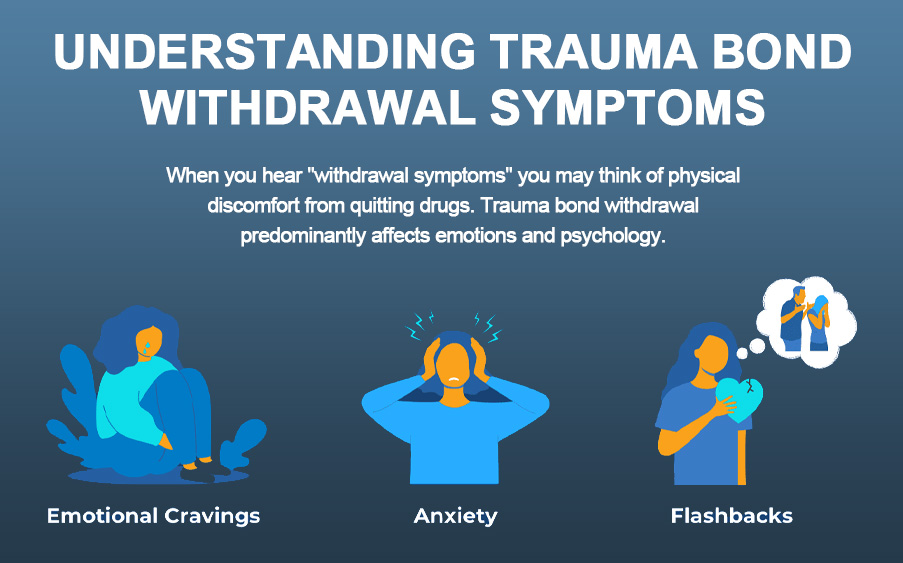Your Largo health and wellness facility welcomes you. We encourage mental health and the recovery from trauma. We acknowledge trauma’s tremendous influence on mental and emotional health and its importance. To help you recover, we’ll discuss “Trauma Bond Withdrawal Symptoms”.
Understanding Trauma Bond
Trauma bonds are complex emotional bonds developed with abusers or toxic people. These psychological and emotional attachments are exceptionally challenging and very hard to break. Understanding trauma bonds a key to healing.
Trauma Bonds Are Characterized By:
- Rewards and punishments build trauma ties, making victims emotionally dependent on the abuser.
- Abusers tie victims with terror.
- Victims of trauma bonding often feel alone because the abuser manipulates their relationships and support systems.
- Manipulation and gaslighting cause guilt and shame, making freedom harder.
Real-Life Examples of Trauma Bonds
Real-life examples exemplify the concept:
- People who have been abused by a partner can develop trauma ties even when they are aware that their abuser is hurting them.
- Children who form mental bonds with caregivers who abuse them may find it hard to break free as adults.
- Hostages may form bonds with their attackers in order to stay alive, even if they hate them.
- People in cults often have traumatic connections with their leaders, which makes it hard to leave.
Understanding the complex dynamics of trauma bonding is essential to healing. It helps people understand these linkages, their harm, and the need for rehabilitation. At BrightPoint MD, we help people break trauma ties and attain mental wellness.
Trauma Bond Withdrawal Symptoms

Understanding Trauma Bond Withdrawal Symptoms
When you hear “withdrawal symptoms” you may think of physical discomfort from quitting drugs. Trauma bond withdrawal predominantly affects emotions and psychology. They result from an abuser’s sudden departure, influence, and manipulation. More about this phenomenon:
Anxiety: The abuser’s sudden absence can cause severe anxiety. Even after the abuser leaves, victims may worry about their actions and reactions.
Depression: After escaping the abuser, people typically feel depressed and hopeless. They may struggle with loss and emptiness.
Attachment issues: Trauma ties can alter healthy attachment patterns. After escaping, people may struggle to build healthy connections or be drawn to poisonous dynamics.
Guilt and Self-Blame: Victims may feel guilty about leaving or reporting their abuser. Emotional burdens can overwhelm.
Hypervigilance: Trauma bond sufferers may always be on guard, fearing threats even after they are gone.
Nightmares and flashbacks: Trauma-related memories and nightmares can disrupt sleep.
The Trauma Recovery Scale
In trauma recovery, progress and treatment strategies must be measured. Bright Point MD uses the “Trauma Recovery Scale” to assess and help clients heal.
The trauma recovery scale is a thorough diagnostic instrument for trauma recovery. We can identify areas where customers may need personalized support based on their specific experiences and problems.
BrightPoint MD values individualized care. We use the Trauma Recovery Scale to assess clients starting trauma recovery.
At Bright Point MD, we are deeply committed to supporting individuals on their journey to healing from trauma. Our comprehensive approach and a range of specialized services are designed to provide the utmost care and guidance as you embark on this path to recovery.
Our Services and Support
Our trauma-focused therapies are customized for each client. Therapy for trauma ties and withdrawal symptoms promotes healing and psychological wellness.
Group and Individual Counseling
In a safe and sympathetic environment, our experienced therapists offer one-on-one and group therapy to share your experiences and connect with people who understand.
Trauma Healing Scale Assessment
The Trauma Recovery Scale helps us analyze your progress and adjust our interventions to your needs.
Trauma Recovery Retreat
Our Trauma Recovery Retreat is a place where you can heal. Our experts will help you rest and recover in peace.
Our Approach and methods
We use evidence-based therapy and compassionate care for trauma rehabilitation. Among our key therapies and methods are:
1. Cognitive-Behavioral Therapy (CBT)
Cognitive-Behavioral Therapy (CBT) helps manage trauma symptoms by identifying and changing harmful ideas and behaviors.
2. Cognitive-Behavioral Therapy (CBT)
A specialized treatment can assist process painful memories and decrease their emotional impact.
3. Mindfulness, Meditation
Meditation and mindfulness reduce stress, anxiety, and emotional reactivity.
4. Informed Trauma Care
Each member of our trauma-informed team provides compassionate care.
Retreat and Scale for Trauma Recovery
Healing is deeper at our trauma recovery retreat. This program’s tranquilly and therapeutic approaches let you focus on recovery in a safe and supportive atmosphere. This program tracks your progress and adjusts treatment using the Trauma Recovery Scale.
For More Information: Visit our blogs
Final Thoughts!
Finally, rehabilitation requires understanding trauma bonds and withdrawal symptoms. Breaking these attachments is emotionally painful, but recovery is possible. BrightPoint MD provides information, support, and therapy during this journey.
We care about your health and understand that healing is personal. Our skills, knowledge, and resources can help you overcome trauma and discover emotional stability and fulfillment.
FQA's
Trauma bond withdrawal lasts differently for everyone. It depends on the trauma’s degree, the person’s resilience, and assistance and treatment. Some symptoms improve in months, others in years. Professional assistance can speed recovery.
Trauma bond withdrawal is difficult, however there are ways to cope:
- Therapy and counseling can help you understand trauma and your feelings.
- Develop a solid support system of friends and family who understand.
- Manage anxiety and sadness with self-care and mindfulness.
- Have fun and find purpose in your hobbies.
- Consider trauma bond support groups.
Trauma bonding can manifest as cognitive dissonance and complex emotions. It can combine love, fear, attachment, and guilt. Trauma bond victims may love and despise their abuser. Overwhelming emotional distress sometimes leads to helplessness and bewilderment.
The Trauma Recovery Scale is a thorough trauma recovery evaluation tool. It assesses mental and emotional wellness to help therapists and healthcare practitioners identify recovery requirements. This diagnostic tool helps create a customized treatment plan and measure progress.
Recovery from trauma is a process that usually takes more than one step. Here are some of those steps:
- Safety and Stabilization: The first step is to make the surroundings safe and stable, both physically and emotionally.
- Remembering and Mourning: At this stage, people face and work through the painful memories and feelings that come with them.
- Reconnection: In this stage, you get back in touch with yourself, build healthy relationships, and trust and connect with others again.
- Integration: The last step is to let the trauma be a part of your life, find meaning in it, and move on with a new sense of purpose and well-being.

